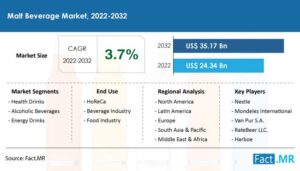Malt Beverage Market In the ever-evolving landscape of the beverage industry, one segment that has been making significant waves is the malt beverage market. Malt beverages, often referred to as “malternatives,” have captured the attention of consumers with their diverse flavors, innovative ingredients, and unique positioning in the market. In this article, we will delve into the malt beverage market, exploring its trends, growth trajectory, and the opportunities it presents for both consumers and businesses.
For More insights into the, Request a Sample of this Report:
Understanding Malt Beverages: A Brief Overview
Malt beverages are a category of alcoholic drinks that are brewed from malted grains, such as barley, wheat, or sorghum. They typically contain lower alcohol content than traditional beers and are known for their wide range of flavors, which can include fruit, spices, herbs, and even botanicals. Malt beverages offer an alternative to traditional beer and have gained popularity among consumers who are looking for something different and more experimental.
Trends Shaping the Malt Beverage Market
- Flavor Innovation: One of the driving factors behind the growth of the malt beverage market is the emphasis on flavor innovation. Malt beverage manufacturers are continuously experimenting with unique and exotic flavors, catering to the evolving taste preferences of consumers. From tropical fruit-infused varieties to spicy and tangy options, the diverse flavor profiles of malt beverages have helped them stand out in a crowded market.
- Health and Wellness: With an increasing focus on health and wellness, many consumers are seeking lighter and lower-calorie alcoholic beverage options. Malt beverages have capitalized on this trend by offering products with reduced sugar content, gluten-free formulations, and natural ingredients. This health-conscious approach has resonated well with a health-conscious consumer base.
- Ready-to-Drink (RTD) Convenience: The convenience of ready-to-drink malt beverages has contributed significantly to their popularity. These beverages are often packaged in cans or bottles, making them portable and easy to consume on-the-go. This convenience factor appeals to busy consumers who seek enjoyable and refreshing alcoholic options without the need for elaborate preparation.
- Market Diversification: The malt beverage market has diversified to cater to various demographics and occasions. Some brands are targeting younger consumers with playful and colorful packaging, while others are focusing on premium and sophisticated offerings for more discerning tastes. This versatility has allowed malt beverages to find a place in different social settings and occasions.
Growth and Opportunities
The malt beverage market has experienced robust growth over the past few years, and this trend is expected to continue. The increasing consumer demand for novel and engaging drinking experiences, coupled with the market’s ability to adapt to changing preferences, positions malt beverages for further expansion.
- Untapped Markets: While malt beverages have gained traction in many regions, there are still untapped markets with significant growth potential. As consumer awareness of malt beverages continues to increase, manufacturers have an opportunity to introduce their products to new demographics and regions, thereby expanding their market reach.
- Collaborations and Cross-Industry Partnerships: Collaboration between malt beverage producers and other industries, such as the food sector or the entertainment industry, can create exciting marketing campaigns and product innovations. These partnerships can help increase brand visibility and engage consumers in new and creative ways.
- Sustainable Practices: The growing emphasis on sustainability presents an opportunity for malt beverage manufacturers to adopt eco-friendly practices throughout their supply chain. Consumers are increasingly drawn to brands that prioritize environmental responsibility, and by incorporating sustainable practices, malt beverage companies can enhance their appeal and capture a broader customer base.
In conclusion, the malt beverage market is a dynamic and rapidly evolving segment of the beverage industry. Its ability to adapt to changing consumer preferences, coupled with its focus on flavor innovation, health-conscious options, and convenience, has contributed to its impressive growth. As the market continues to expand and diversify, it presents numerous opportunities for businesses to capture new audiences and create exciting, trendsetting products. Whether you’re a consumer seeking a refreshing alternative or a business looking to tap into a thriving market, the malt beverage industry is a space worth keeping an eye on.
